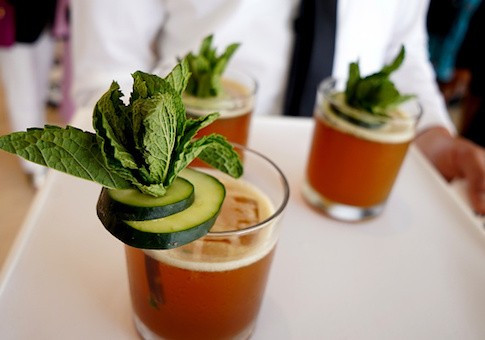Prior to a conference, I was at a hotel bar with a colleague who had just turned 21. When the bartender came to take our order, I asked for a martini up with olives. My friend, on the other hand, said, "Long Island Iced Tea." The bartender promptly asked for his I.D.
And why wouldn't he? The Long Island Iced Tea has long been a college favorite and often a dead giveaway that the customer is underage. It combines vodka, rum, gin, triple sec, and tequila, with a splash of Coke—its purpose is obvious. (As Marge Simpson once said, "They ought to call that a large island iced tea!")
It's also a far cry from the first cocktail. "The original meaning of cocktail in the nineteenth century was something fairly specific," writes Derek Brown in Spirits, Sugar, Water, Bitters: How the Cocktail Conquered the World, "not just any alcoholic beverage, but that magical combination of just four ingredients—spirit, sugar, water, and bitters."
From those four elements sprang the whiskey cocktail, which evolved into the Old Fashioned. Add vermouth and it turns into a Manhattan. Replace whiskey with gin and it transforms into a Martini, which as far as Brown is concerned, means gin and not vodka (I'm with him on this). Brown's recipe for the Martini, however, is sure to stir up trouble as it calls for equal parts gin and vermouth. It sounds insane until you add orange bitters, which lend softness and balance. (It might also explain how three Martini lunches were possible back in the day—that and smaller glasses.)
Brown is a bar owner and calls himself a mixologist, a term that can involve a bit of eye-rolling. Even President Obama, when introduced to him at a White House reception, asked Brown, "Isn't that just a bartender?" In fact, as he points out in his book, the term mixologist dates to at least 1856, where a "mixologist of tipulars" is mentioned in Knickerbocker Magazine. The word cocktail, however, appears as far back as 1806—a newspaper in Hudson, N.Y., mentions a politician having spent money on "25 cock tails" and other spirits in exchange for votes (alas, this particular candidate lost).
If you haven't noticed, Brown is a drinks historian too. In 2015 he was even named chief spirits adviser to the National Archives Foundation and jokes that this makes him "the highest-ranking bartender in the U.S. government." But during his stint he conducted a series of popular seminars on the history of the cocktail (I moderated the panel on David Embury's seminal The Fine Art of Mixing Drinks and 1950s drinking culture).
From those seminars came the idea for Spirits, Sugar, Water, Bitters, a need to distill (sorry!) the history of this truly American invention, "the quintessential American drink," as Brown puts it. And what better time than the present? Last year we went through 231 million cases according to the Distilled Spirits Council. The volume for rye whiskey alone has shot up over the past 10 years by more than 1,000 percent, although vodka is still king, accounting for 72 million cases (31 percent of all spirits consumption).
Keep in mind this doesn't mean Americans are personally drinking more than ever. As Brown points out, we currently consume on average 2.3 gallons of booze a year. Compare this with early 19th-century Americans who drank at Jim Morrison levels—7 gallons of alcohol annually.
Our preferences have changed over the centuries, often depending on circumstance, going from wine (Madeira was a George Washington favorite) to sherry to rum. Following the Molasses Act and the Revolutionary War we turned to whiskey and then to vodka in the mid 1970s. Throughout Spirits, Sugar, Water, Bitters, Brown gives us a sampling of cocktails reflecting the times. So there are recipes for long-forgotten drinks like the Syllabub alongside classics such as the Sazerac and the Mai Tai, plus the four foundational cocktails every home bartender should know: the Martini, the Manhattan, the Old Fashioned, and the Daiquiri.
Brown reminds us we lost countless recipes (and jobs) thanks to Prohibition, which wiped our drinking culture off the map. But almost as bad were the 1970s and '80s, which Brown calls the Dark Ages. "Cocktails made with cheap booze, fruit juices, and lots of sweeteners became ascendant. … The real focus for most Americans was just getting drunk, or achieving a similarly altered state." It was a time of Kamikaze shooters, the Fuzzy Navel, the Slippery Nipple, and yes, Sex on the Beach. This libation, consisting of peach schnapps, vodka, cranberry juice, and orange juice, was supposedly first created during spring break in Fort Lauderdale in 1987. Says Brown, "That seems fitting."
At the same time there were a handful of bartenders—folks like Dale DeGroff and Tony Abou-Ganim— who began to seek out the classic cocktails and push their colleagues to do better than sour mixes and high balls. This led to the resurgence in bitters, rye, liqueurs like créme de violette, and what Brown calls our current Platinum Age (he's even got a timeline on YouTube.).
"We have always loved a good cocktail, no matter how much it changes over time," writes Brown, who admits to once being a snob, looking down on the vodka-soda crowd. No longer, he recently told me. And although he doesn't provide a recipe for the Long Island Iced Tea, he does give us one for the Vodka Espresso, which bartender Dick Bradsell said was invented in 1983 for a model who asked for something "to wake her up, and fuck her up."
Of course there are other reasons to drink. Brown is fond of quoting G.K. Chesterton, who urged us to "never drink because you need it, for this is rational drinking, and the way to death and hell. But drink because you do not need it, for this is irrational drinking, and the ancient health of the world."
